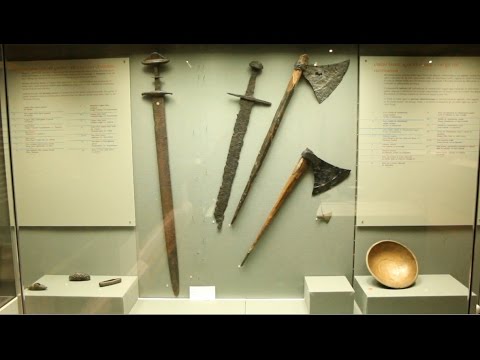More than mere combat weapon, the hardened steel of the iconic Viking Axe was one of history’s first multi-purpose tools.
The term Viking axe is an umbrella term used to describe several different types of axes used by the Vikings during the Viking Age. Amongst the best-known Viking axes are the Dane axe and the bearded axe. Whilst Viking axes were primarily used for combat purposes, it is known that they were also utilized for other less violent purposes. Some, for instance, were employed for ceremonial purposes, whilst others took on a more domestic function.
The tradition of using axes by the Vikings stretches back into the Stone Age, with stone-axes, shaped like boats, found in Scandinavia dating back to 2800BC.

“battle-axe” (Streitaxe) or boat axe of Swedish-Norwegian type, 2800-2400 BC.
Over the millennia, the peoples of Scandinavia became masters of axe-making. As the design of this weapon was perfected, the stone was replaced by metal as the material used to make the axe heads. Typically, these axe heads were made using iron. In some cases a hardened steel edge was added through welding to provide a sharper cutting edge, a method still used today.

Iron & Copper alloy Battle Axe (11th Century)
The axe heads would then be attached to a wooden haft, the length of which varied according to the weapon itself. Compared to the other famous Viking weapon, the sword, Viking axes required less skill to make, as well as much less iron and steel, which were expensive commodities. Due to these factors, the axe was much more affordable, and more readily available. Thus, even the poorest Norseman could have afforded an axe.
Viking axes came in various shapes and sizes and were known by different names. One of these is the Dane axe, which is also known as the English long axe, the Danish axe, and the hafted axe. The Dane axe is a two-handed weapon and was used exclusively for battle. The head of the axe, which has a cutting edge of 20 to 30 cm (7.87 – 11.81 inches), is mounted on a haft that measured between 0.9 and 1.2 meters (2.95-3.94 ft.) The Dane axe is perhaps most famous for its use by the huscarls (household troops) of King Harold II at the Battle of Hastings in 1066 AD and is depicted on the Bayeux Tapestry.

Harold Godwinson falls at Hastings. Harold was struck in the eye with an arrow (left), slain by a mounted Norman knight (right) or both.
Another type of Viking axe is the bearded axe. Unlike the Dane axe, such axes could be wielded with one hand. The distinguishing feature of the bearded axe, was the square-shaped projection at the bottom of the axe head, named "beard", which could be used to hook an enemy’s weapon or shield, thus giving its wielder an advantage during combat. The bearded axe was not used only in battle, as it was also used for wood-working, the chopping of wood, and the harvesting of timber.

A Viking "bearded axe" blade circa 1000 (top), and a German horseman's axe blade circa 1100 (bottom).
Apart from combat and wood related activities, Viking axes also served a ceremonial function and treasures to be taken into the afterlife, an undeniable evidence of the importance of the axe on the Viking daily life.

Danish National Museum - Jutland viking mammon axe -970 AD iron with silver inlay
Sources:
Simek, Rudolf. 2007 (1993). Translated by Angela Hall. Dictionary of Northern Mythology. D.S. Brewer. ISBN 0-85991-513-1
Orchard, Andy. 1997. Dictionary of Norse Myth and Legend. Cassell. ISBN 0-304-34520-2
Ellis-Davidson, Hilda Roderick. 1964. Gods and Myths of Northern Europe. ISBN-13 978-0140136272












